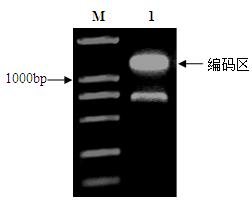Squalene synthase gene of Panax japonicus and application of the gene
A technology of squalene synthase and bamboo ginseng, which is applied in the fields of application, genetic engineering, plant genetic improvement, etc.
- Summary
- Abstract
- Description
- Claims
- Application Information
AI Technical Summary
Problems solved by technology
Method used
Image
Examples
Embodiment 1
[0055] Embodiment 1 The cloning of bamboo ginseng squalene synthase gene
[0056] 1. tissue isolation
[0057] The bamboo-jointed ginseng plant comes from Jinggangshan, Jiangxi, and its roots are immediately frozen in liquid nitrogen and stored in a -80°C refrigerator.
[0058] 2. Total RNA isolation (RNA isolation)
[0059] Part of the tissue was taken and crushed with a mortar, added to a 1.5ml centrifuge tube filled with lysate, shaken thoroughly, and total RNA was extracted according to the instructions of the TRIzol reagent (TRIzol Reagents, Invitrogen, USA). The quality of total RNA was identified by agarose gel electrophoresis, and then the concentration and OD value of RNA were measured on an ultra-micro UV spectrophotometer.
[0060] 3. Cloning of the full-length cDNA of the target gene (Cloning of Full-length cDNA)
[0061] According to the conserved sequences of the squalene synthase genes that have been cloned from Arabidopsis thaliana, tobacco, licorice an...
Embodiment 2
[0073] Example 2 Sequence information and homology analysis of the squalene synthase gene of Bamboo ginseng
[0074] The full-length cDNA of the bamboo ginseng squalene synthase gene of the present invention is 1495bp in length, and the detailed sequence is shown in SEQ ID NO.1, wherein the open reading frame is located at nucleotides 87-1352. According to the full-length cDNA, the amino acid sequence of squalene synthase from bamboo ginseng was deduced, with a total of 421 amino acid residues, a molecular weight of 48.0kD, and a pI of 6.17. See SEQ ID NO.2 for the detailed sequence.
[0075] Log the obtained full-length cDNA sequence and the encoded amino acid sequence of the bamboo ginseng SQS gene on the NCBI website (http: / / www.ncbi.nlm.nih.gov), and use the BLAST program to search GenBank + EMBL + DDBJ respectively + PDB and non-redundant GenBank CDS translations + PDB + SwissProt + PIR + PRF database reported sequences, for nucleotide sequence and amino acid sequence h...
Embodiment 3
[0077] Example 3 Structural analysis and functional prediction of bamboo ginseng squalene synthase or polypeptide
[0078] The amino acid sequence of bamboo ginseng SQS was logged on the NCBI website, and a CDD (Conserved Domain Database) search was performed, and it was found that bamboo ginseng SQS had three conserved regions: 1'-1 trans isopentenyl diphosphate synthase (Trans_IPPS_HH), The enzyme catalyzes two isopentenyl diphosphate "head-to-head" condensation reactions; trans-isopentenyl diphosphate synthase (Trans_IPPS) and isoprenoid biosynthesis enzymes (Isoprenoid Biosynthesis enzymes), Belonging to the first family of isoprenoid biosynthetic enzymes, it can catalyze the synthesis of GPP, FPP or longer isoprenoid products. The catalytic site consists of a large central cavity consisting of two antiparallel α-double helices with walled aspartate-rich domains (DXXXD) that function primarily to bind prenyl phosphate groups , which can respectively catalyze the 1'-1 co...
PUM
 Login to View More
Login to View More Abstract
Description
Claims
Application Information
 Login to View More
Login to View More - R&D
- Intellectual Property
- Life Sciences
- Materials
- Tech Scout
- Unparalleled Data Quality
- Higher Quality Content
- 60% Fewer Hallucinations
Browse by: Latest US Patents, China's latest patents, Technical Efficacy Thesaurus, Application Domain, Technology Topic, Popular Technical Reports.
© 2025 PatSnap. All rights reserved.Legal|Privacy policy|Modern Slavery Act Transparency Statement|Sitemap|About US| Contact US: help@patsnap.com



